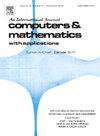演化方程系统的解耦技术
IF 2.9
2区 数学
Q1 MATHEMATICS, APPLIED
引用次数: 0
摘要
研究了演化方程耦合系统Cauchy问题近似解的数值方法。为解决方案的各个组成部分分离更简单的子问题,在时间上实现了问题在一个新的水平上的简化。解耦方法是一种简化问题的重要方法,它基于对问题算子矩阵的分解。近似解是基于辅助问题解的线性组合构造的。本文研究了基于算子矩阵对角部分和上下三角子矩阵提取的解耦变体。该研究引入了一种新的分解方法,将算子矩阵分解为行和列。合成阶段利用了分裂方案的各种变体,展示了该方法的多功能性。在加性算子差分格式中,我们可以区分出显式-隐式格式、双组分分裂的分解格式和一般多组分分裂的正则化格式。利用有限维Hilbert空间算子差分格式的稳定性(正确性)理论,研究了两层和三层解耦组合格式的稳定性。通过一个非齐次自扩散系数和交叉扩散系数的扩散方程耦合系统的二维试验问题,说明了演化方程系统解耦技术的理论结果。本文章由计算机程序翻译,如有差异,请以英文原文为准。
Decoupling technology for systems of evolutionary equations
Numerical methods of approximate solution of the Cauchy problem for coupled systems of evolution equations are considered. Separating simpler subproblems for individual components of the solution achieves simplification of the problem at a new level in time. The decoupling method, a significant approach to simplifying the problem, is based on the decomposition of the problem's operator matrix. The approximate solution is constructed based on the linear composition of solutions to auxiliary problems. The paper investigates decoupling variants based on extracting the diagonal part of the operator matrix and the lower and upper triangular submatrices. The study introduces a new decomposition approach, which involves splitting the operator matrix into rows and columns. The composition stage utilizes various variants of splitting schemes, showcasing the versatility of the approach. In additive operator-difference schemes, we can distinguish explicit-implicit schemes, factorized schemes for two-component splitting, and regularized schemes for general multi-component splitting. The study of stability of two- and three-level decoupling composition schemes is carried out using the theory of stability (correctness) of operator-difference schemes for finite-dimensional Hilbert spaces. The theoretical results of the decoupling technique for systems of evolution equations are illustrated on a test two-dimensional problem for a coupled system of two diffusion equations with inhomogeneous self- and cross-diffusion coefficients.
求助全文
通过发布文献求助,成功后即可免费获取论文全文。
去求助
来源期刊

Computers & Mathematics with Applications
工程技术-计算机:跨学科应用
CiteScore
5.10
自引率
10.30%
发文量
396
审稿时长
9.9 weeks
期刊介绍:
Computers & Mathematics with Applications provides a medium of exchange for those engaged in fields contributing to building successful simulations for science and engineering using Partial Differential Equations (PDEs).
 求助内容:
求助内容: 应助结果提醒方式:
应助结果提醒方式:


